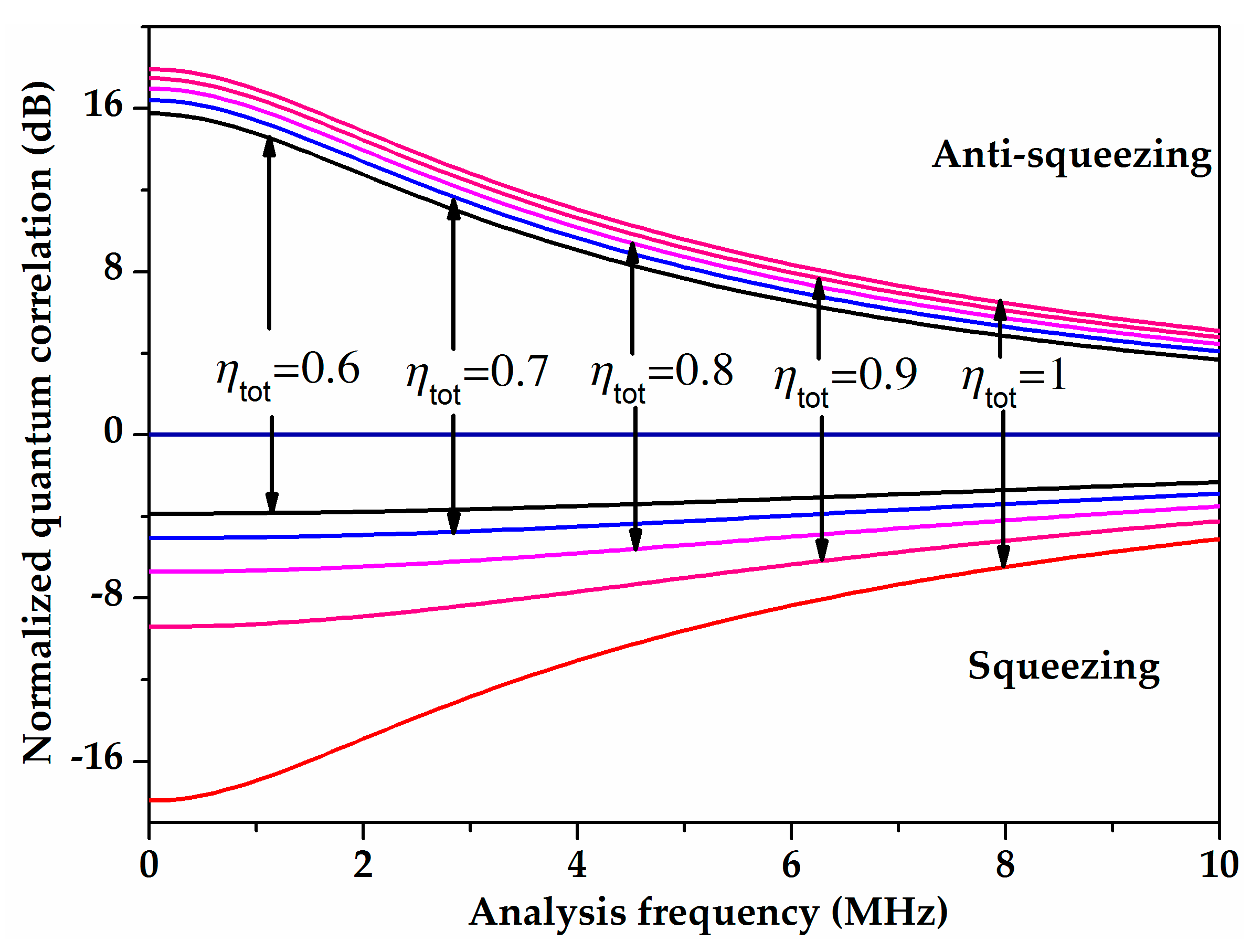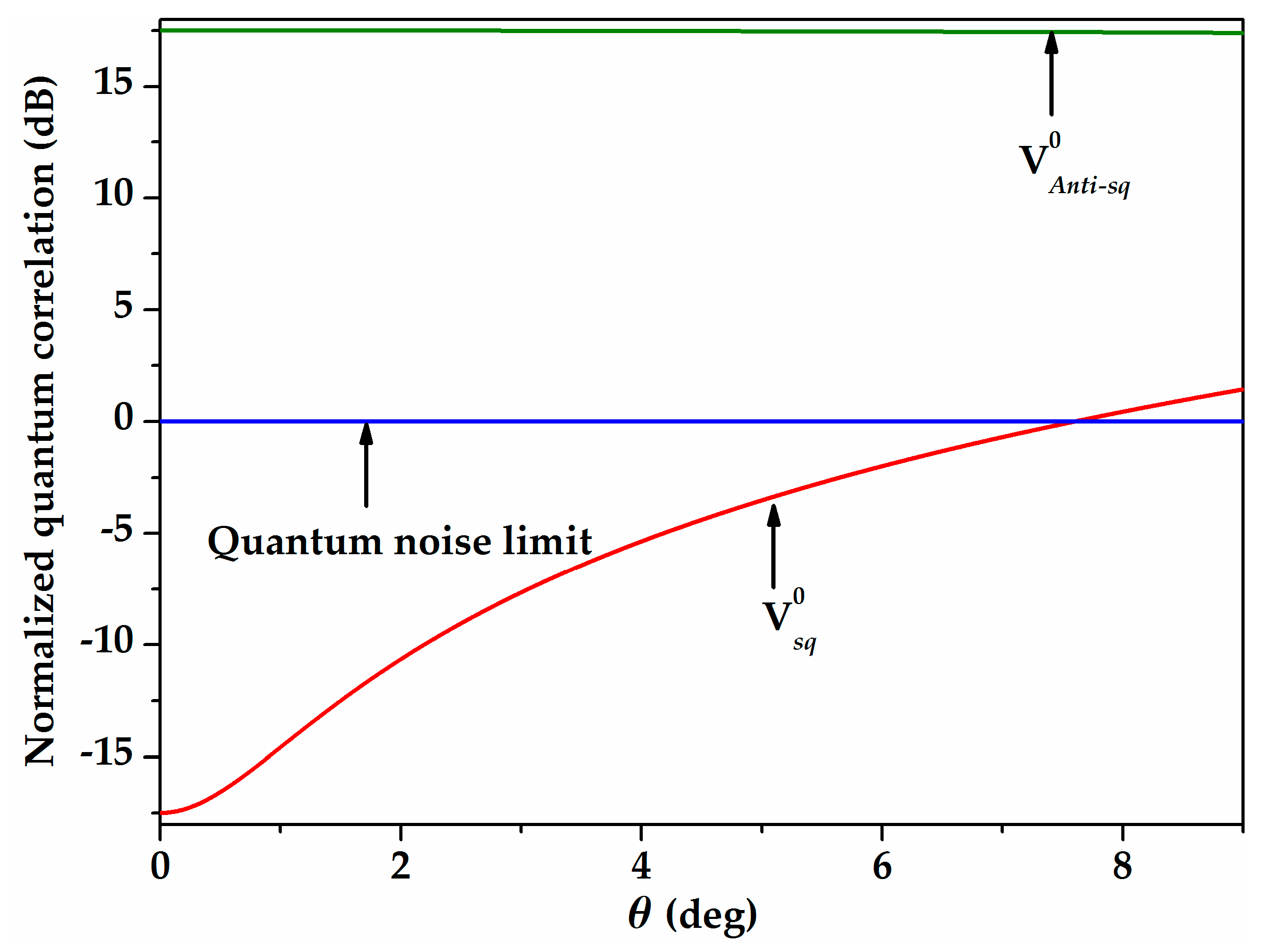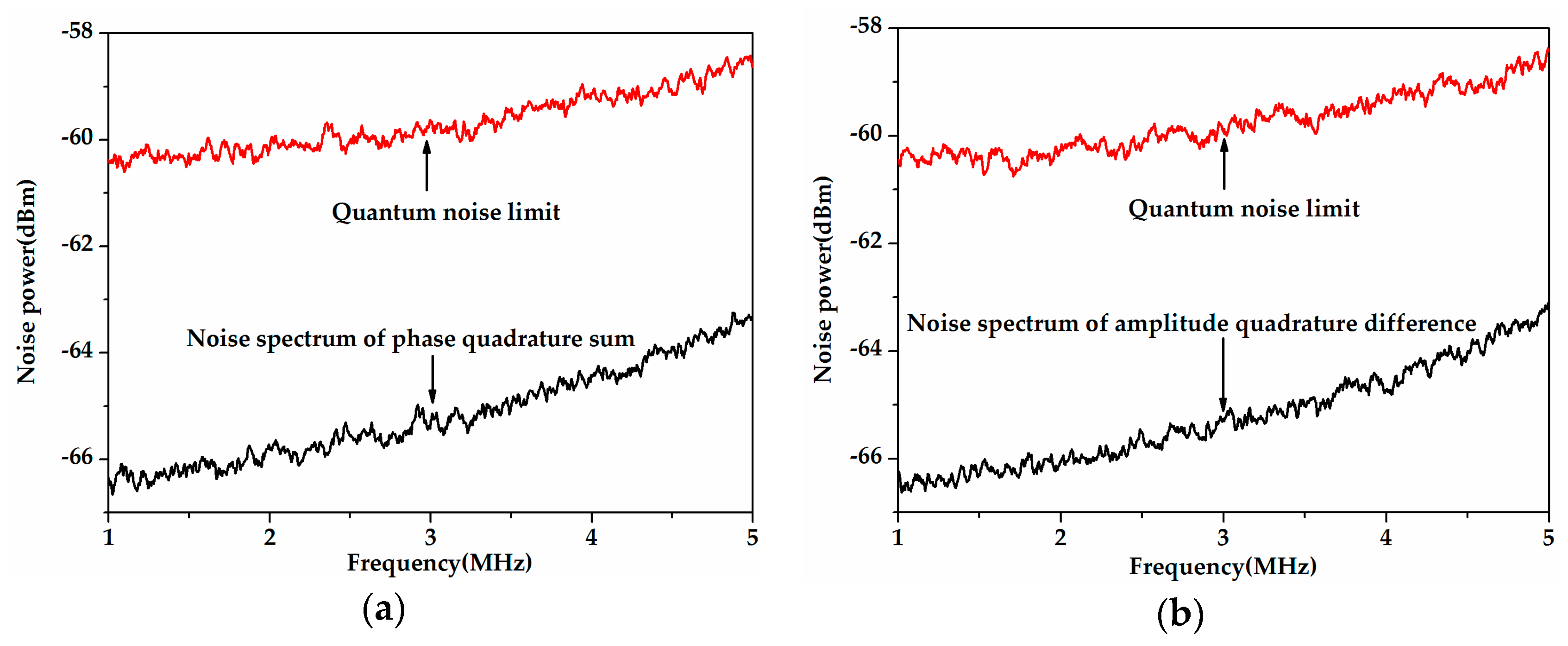Compact 6 dB Two-Color Continuous Variable Entangled Source Based on a Single Ring Optical Resonator
Abstract
:1. Introduction
2. Theoretical Analysis
3. Experimental Setup
4. Results and Discussion
5. Conclusions
Acknowledgments
Author Contributions
Conflicts of Interest
References
- Horodecki, R.; Horodecki, P.; Horodecki, M.; Horodecki, K. Quantum entanglement. Rev. Mod. Phys. 2009, 81, 865–942. [Google Scholar] [CrossRef]
- Ladd, T.D.; Jelezko, F.; Laflamme, R.; Nakamura, Y.; Monroe, C.; O’Brien, J.L. Quantum computers. Nature 2010, 464, 45. [Google Scholar] [CrossRef] [PubMed]
- Kimble, H.J. The quantum internet. Nature 2008, 453, 1023–1030. [Google Scholar] [CrossRef] [PubMed]
- Cerf, N.J.; Leuchs, G.; Polzik, E.S. Quantum Information with Continuous Variables of Atoms and Light; Imperial College Press: London, UK, 2007; p. 632. [Google Scholar]
- Guo, X.M.; Xie, C.D.; Li, Y.M. Generation and homodyne detection of continuous-variable entangled optical beams with a large wavelength difference. Phys. Rev. A 2011, 84, 1892. [Google Scholar] [CrossRef]
- Guo, X.M.; Zhao, J.J.; Li, Y.M. Robust generation of bright two-color entangled optical beams from a phase-insensitive optical parametric amplifier. Appl. Phys. Lett. 2012, 100, 091112. [Google Scholar] [CrossRef]
- Goda, K.; Miyakawa, O.; Mikhailov, E.E.; Saraf, S.; Adhikari, R.; Mchenzie, K.; Ward, R.; Vass, S.; Weinstein, A.J.; Mavalvala, N. A quantum-enhanced prototype gravitational-wave detector. Nat. Phys. 2008, 4, 472–476. [Google Scholar] [CrossRef]
- Grote, H.; Danzmann, K.; Dooley, K.L.; Schnabel, R.; Slutsky, J.; Vahlbruch, H. First long-term application of squeezed states of light in a gravitational-wave observatory. Phys. Rev. Lett. 2013, 110, 181101. [Google Scholar] [CrossRef] [PubMed]
- Giovannetti, V.; Lloyd, S.; Maccone, L. Advances in quantum metrology. Nat. Photonics 2011, 96, 222–229. [Google Scholar] [CrossRef]
- Polzik, E.S.; Carri, J.; Kimble, H.J. Spectroscopy with squeezed light. Phys. Rev. Lett. 1992, 68, 3020. [Google Scholar] [CrossRef] [PubMed]
- Polzik, E.S.; Carri, J.; Kimble, H.J. Atomic spectroscopy with squeezed light for sensitivity beyond the vacuum-state limit. Appl. Phys. B 1992, 55, 279–290. [Google Scholar] [CrossRef]
- Li, Y.Q.; Lynam, P.; Xiao, M.; Edwards, P.J. Sub-shot-noise laser doppler anemometry with amplitude-squeezed light. Phys. Rev. Lett. 1997, 78, 3105–3108. [Google Scholar] [CrossRef]
- Li, Y.Q.; Guzun, D.; Xiao, M. Sub-shot-noise-limited optical heterodyne detection using an amplitude-squeezed local oscillator. Phys. Rev. Lett. 1999, 82, 5225–5228. [Google Scholar] [CrossRef]
- Madsen, L.S.; Usenko, V.C.; Lassen, M.; Filip, R.; Andersen, U.L. Continuous variable quantum key distribution with modulated entangled states. Nat. Commun. 2012, 3, 1083. [Google Scholar] [CrossRef] [PubMed]
- Ralph, T.C. Continuous variable quantum cryptography. Phys. Rev. A 1999, 61, 103031–103034. [Google Scholar] [CrossRef] [Green Version]
- Briegel, H.J.; Dür, W.; Cirac, J.I.; Zoller, P. Quantum repeaters for communication. Phys. Rev. Lett. 1998, 81, 5932. [Google Scholar] [CrossRef]
- Sangouard, N.; Simon, C.; Riedmatten, H.D.; Gisin, N. Quantum repeaters based on atomic ensembles and linear optics. Rev. Mod. Phys. 2009, 83, 33–34. [Google Scholar] [CrossRef]
- Azuma, K.; Tamaki, K.; Lo, H.K. All-photonic quantum repeaters. Nat. Commun. 2015, 6, 6787. [Google Scholar] [CrossRef] [PubMed]
- Schori, C.; Sorensen, J.L.; Polzik, E.S. Narrow-band frequency tunable light source of continuous quadrature entanglement. Phys. Rev. A 2002, 66, 355–358. [Google Scholar] [CrossRef]
- Villar, A.S.; Cruz, L.S.; Cassemiro, K.N.; Martinelli, M.; Nussenzveig, P. Generation of bright two-color continuous variable entanglement. Phys. Rev. Lett. 2005, 95, 243603. [Google Scholar] [CrossRef] [PubMed]
- Su, X.; Tan, A.; Jia, X.; Pan, Q.; Xie, C.; Peng, K. Experimental demonstration of quantum entanglement between frequency-nondegenerate optical twin beams. Opt. Lett. 2006, 31, 1133–1135. [Google Scholar] [CrossRef] [PubMed]
- Jing, J.; Feng, S.; Bloomer, R.; Pfister, O. Experimental continuous-variable entanglement of phase-locked bright optical beams. Phys. Rev. A 2006, 4250, 158. [Google Scholar]
- Grosse, N.B.; Assad, S.; Mehmet, M.; Schnabel, R.; Symul, T.; Lam, P.K. Observation of entanglement between two light beams spanning an octave in optical frequency. Phys. Rev. Lett. 2008, 100, 243601. [Google Scholar] [CrossRef] [PubMed]
- Li, Y.; Guo, X.; Bai, Z.; Liu, C. Generation of two-color continuous variable quantum entanglement at 0.8 and 1.5 μm. Appl. Phys. Lett. 2010, 97, 031107. [Google Scholar] [CrossRef]
- Liu, W.; Wang, N.; Li, Z.; Li, Y. Quantum frequency up-conversion of continuous variable entangled states. Appl. Phys. Lett. 2015, 107, 116. [Google Scholar] [CrossRef]
- Coelho, A.S.; Barbosa, F.A.S.; Cassemiro, K.N.; Villar, A.S.; Martinelli, M.; Nussenzveig, P. Three-color entanglement. Science 2009, 326, 823–826. [Google Scholar] [CrossRef] [PubMed]
- Yu, Y.; Ji, F.; Shi, Z.; Wang, H.J.; Zhao, J.; Wang, Y. Three-color entanglement generated by single-pass cascaded sum-frequency processes. Laser Phys. Lett. 2017, 14, 035202. [Google Scholar] [CrossRef]
- Jia, X.J.; Yan, Z.H.; Duan, Z.Y.; Su, X.; Wang, H.; Xie, C.D.; Peng, K.C. Experimental realization of three-color entanglement at optical fiber communication and atomic storage wavelengths. Phys. Rev. Lett. 2012, 109, 253604. [Google Scholar] [CrossRef] [PubMed]
- Zhang, Y.; Kasai, K.; Watanabe, M. Classical and quantum properties of optical parametric amplifier/deamplifier. Phys. Lett. A 2002, 297, 29–36. [Google Scholar] [CrossRef]
- Dwyer, S.; Barsotti, L.; Chua, S.S.Y.; Evans, M.; Factourovich, M.; Gustafson, D.; Isogai, T.; Kawabe, K.; Khalaidovski, A.; Lam, P.K.; et al. Squeezed quadrature fluctuations in a gravitational wave detector using squeezed light. Opt. Express 2013, 21, 19047–19060. [Google Scholar] [CrossRef] [PubMed]
- Breitenbach, G.; Schiller, S.; Mlynek, J. 81% conversion efficiency in frequency-stable continuous-wave parametric oscillation. J. Opt. Soc. Am. B 1995, 12, 2095–2101. [Google Scholar] [CrossRef]
- Fabre, C.; Rosencher, E. Oscillation characteristics of continuous-wave optical parametric oscillators: Beyond the mean-field approximation. J. Opt. Soc. Am. B 2002, 19, 1107–1116. [Google Scholar]
- Coelho, A.S.; Cesar, J.E.S.; Cassemiro, K.N.; Villar, A.S.; Nussenzveig, P.; Martinelli, M. Extra phase noise from thermal fluctuations in nonlinear optical crystals. Phys. Rev. A 2009, 79, 063816. [Google Scholar]





| Works | T | L | (Mrad) | Observed Entangled Level (dB) | ||||
|---|---|---|---|---|---|---|---|---|
| Guo et al. [6] | 6.7% | 1.6% | 96% | 94% | 75% | 100% | 40 | 3.3 |
| This work | 10.2% | 1.1% | 96% | 96% | 92% | 99.8% | 8.7 | 6 |
© 2018 by the authors. Licensee MDPI, Basel, Switzerland. This article is an open access article distributed under the terms and conditions of the Creative Commons Attribution (CC BY) license (http://creativecommons.org/licenses/by/4.0/).
Share and Cite
Wang, N.; Du, S.; Li, Y. Compact 6 dB Two-Color Continuous Variable Entangled Source Based on a Single Ring Optical Resonator. Appl. Sci. 2018, 8, 330. https://doi.org/10.3390/app8030330
Wang N, Du S, Li Y. Compact 6 dB Two-Color Continuous Variable Entangled Source Based on a Single Ring Optical Resonator. Applied Sciences. 2018; 8(3):330. https://doi.org/10.3390/app8030330
Chicago/Turabian StyleWang, Ning, Shanna Du, and Yongmin Li. 2018. "Compact 6 dB Two-Color Continuous Variable Entangled Source Based on a Single Ring Optical Resonator" Applied Sciences 8, no. 3: 330. https://doi.org/10.3390/app8030330






